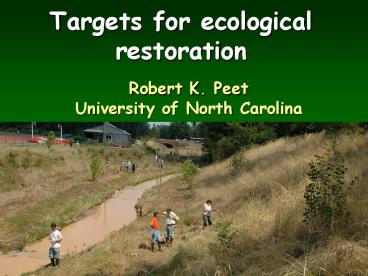Targets for ecological restoration - PowerPoint PPT Presentation
1 / 25
Title:
Targets for ecological restoration
Description:
... functions associated with wetlands, streams, and riparian areas, including ... restoration, maintenance and protection of water quality and riparian habitats ... – PowerPoint PPT presentation
Number of Views:166
Avg rating:3.0/5.0
Title: Targets for ecological restoration
1
Targets for ecological restoration
- Robert K. Peet
- University of North Carolina
2
1. Introduction
- Why me? Im not a restoration ecologist.
- Icon an object of uncritical
devotionespecially a traditional belief or
ideal - My icon a simple model for how to conduct
ecological restoration. - My approach A Carolina case study
- Goal ecological function biodiversity
3
2. A methodological icon
- Document reference conditions
- Derive restoration targets
- Design site-specific restoration plan
- Implement the plan
- Monitor change and assess success
- Employ adaptive management
4
3. Carolina Vegetation Survey
- Multi-institutional collaborative study to
document and understand the natural vegetation of
the Carolinas.
- High-quality, quantitative records of reference
vegetation
5
Over 5000 plots, containing over 2600 species,
representing over 200 vegetation types.
Reference data collection is an on-going activity
6
4. North Carolina Ecosystem Enhancement Program
- The EEP mission is to restore, enhance,
preserve and protect the functions associated
with wetlands, streams, and riparian areas,
including restoration, maintenance and
protection of water quality and riparian habitats
7
Ecosystem Enhancement Program
Biennial Budget FY 2005/06 and 2006-07 Cost by
Category Total 175,077,880
Summary Administration
9,477,939 Restoration
102,910,770 HQ Preservation
57,984,804 Project Development
4,704,366 Includes Implementation and Biennial
Total 175,077,880 Future
Mitigation Projects
8
Stream Restoration Durham, NC
9
5. Traditional EEP method
- Consult brief habitat-based plant lists
- Design a site-specific restoration plan
- Implement the plan
- Monitor survival of planted stems 5 yrs
- Replant if needed
10
6. EEP-CVS Collaboration
- EEP wants to do a better job creating natural
ecosystems. - CVS provides improved reference data, target
design, monitoring, and data management and
analysis
11
7. Reference site initiative
- Goal move from modest species lists to a
quantitative plot database and high-resolution
community classification with quantitative
descriptions and defined environmental settings.
12
8. Target generation
- Simple goal Deliver composition goal based on
the vegetation type most appropriate for the site
and region. - Sophisticated goal. Automated system that uses
site data to generate likely NVC types, from
which compositional goals are extracted.
13
- Longleaf pine feasibility study
- Few longleaf pine sites remain in original
condition. - Restoration targets must be extrapolated from a
limited number of reference stands.
14
- Dataset
- 188 plots across fall-line sandhills of NC, SC,
GA - - All sites contained near-natural,
fire-maintained groundlayer vegetation - - Soil attributes included for both the A and B
horizon sand, silt, clay, Ca, Mg, K, P, S, Mn,
Na, Cu, Zn, Fe, BD, pH, organic content, CEC, BS.
15
Step 1. Classification. Developed a
classification of the major vegetation types of
the ecoregion. Used cluster analysis with a
matrix of 188 plots x 619 species. Vegetation
types were seen to be differentiated with respect
to soil texture, moisture, nutrient status,
geography.
16
- Step 2. Build model.
- - Forward selection with linear discriminant
analysis identified predictor variables. - Critical variables were Latitude, Manganese,
Phosphorus, Clay, Longitude. - 75 of plots correctly identified to series.
Typically 75 of communities within a series that
were correctly classified.
17
- Step 3. Select species.
- Generate a list of all species in type (species
pool) with frequency, mean cover values, and mean
richness. - Randomly order the list
- Compare species frequency to random number
between 0 1, and if the random number is less
than the proportion of plots the species is
selected. Continue until the number in list of
selected species equals the number predicted.
18
- Overall strategy
- Identify biogeographic region and obtain
predictive models. - Select pool of candidate species for a specific
site based on range information. - Divide restoration site into environmentally
homogenous areas, stratifying by topography and
soil. - Use models to select species number and
composition.
19
9. Monitoring CVS methods
20
- Trade off between detail and time.
- EEP protocol seamlessly integrates with CVS
methods by allowing a series of sampling levels. - MS-Access data-entry tool to assure standardize
data, easy assimilation, and automated quality
control. - Standard backend database for reports and analysis
21
(No Transcript)
22
10. Reports Analysis
- Datasheets for monitoring
- Survival growth of planted stems
- Direction of compositional change
- Rate of change
- Problems needing attention, such as exotic
species
23
CVS-EEP Training is essential
24
11. Reference stand issues
- Reference stand conditions may be difficult to
achieve because of altered - Soil nutrients
- Herbivory
- Hydology
- Exotic species, and diseases
- Disturbance regimes
- Sea level
- Climate
25
12. Concluding remarks
- The iconic model, although analytically simple,
provides a firm foundation. - My case study lacks the sophisticated but
impractical approaches generally advocated at an
ESA symposium, yet it improves on a highly
respected program. - Dont forget Robert Mays observation that
ecology is a science of contingent
generalization. The CVS method focuses on
contingencies of site and history.































